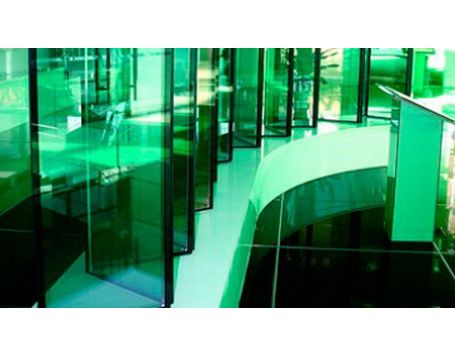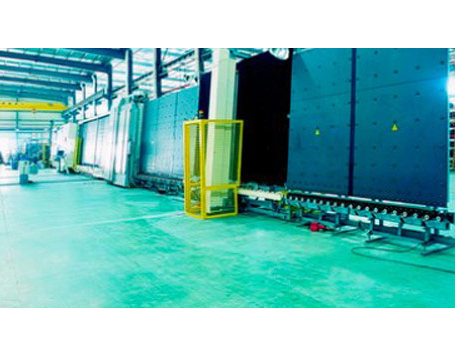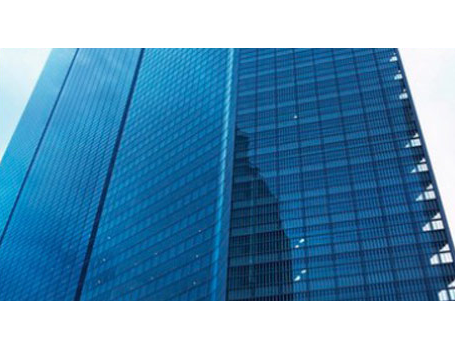Low-E Coated Glass
Product Description
Low emissivity coated glass is also called Low-E glass. Low-E glass is to coat low emissivity silver and metal oxide layers on glass surface. The coatings on glass will show different colors. Its major properties is to lower the U-value and selectively lower the SC which on the whole improves the glass energy efficiency. It features high infrared reflection. It can directly reflect far infrared. Because of its low surface emissivity(E), it absorbs and re-radiates very little energy. It has a wide range of shading coefficient(SC) which can meet different solar control requirements according to different climates. It can be divided into high transmission low-E glass and solar control low-E glass. High transmission Low-E glass has shading coefficient Sc≥0.5 which does not reduce too much solar heat. It is very suitable to be used in the northern area where heating system is adopted. In winter, sun rays can transmit through this type of Low-E glass into the room and the energy is absorbed by interior objects. The objects in the room will re-rediate far infrared which cannot pass through the Low-E glass. Such solar heat is confined indoors together with the heat from the indoor heaters. Thus, heating costs can be reduced. Solar Control Low-E glass has shading coefficient Sc<0.5 which can reduce solar heat transmission. It is very suitable to be used in the southern area where air conditioner is used for cooling. In summer, it can block solar heat from entering the room as well as to block scattered far infrared from outdoors. Thus, the costs of air conditioning can be reduced. According to the number of silver layers in the coating, it can be categorised into single-silver Low-E glass, double-silver Low-E glass and triple-silver low-E glass. In some occasions, requirements of high visible light transmittance and very low shading coefficient is needed. This drives the development of Double-silver Low-E glass. In general, double-silver Low-E glass has higher visible light transmittance than single-silver Low-E glass when both have the same SC. This feature is even more obvious in Triple-silver Low-E glass. Double-silver glass has a wide range of application. It has the following characteristics: lower shading coefficient than solar control Low-E glass, low emissivity allow good heat preservation, low reflectance, and better transmittance.


Definition of Low-E insulating glass, comparison between monolithic clear glass and clear insulating glass in energy saving
Low-E insulating glass, a recognised energy saving building material, is advocated to use in green architecture by the country. It can meet or even out perform the requirements stated in the national standards for energy conservation of materials used in public buildings and residential buildings. The Low-E coating is made by using vacuum magnetron sputtering technology to deposit metallic silver and auxiliary layers on glass surface. It is then assembled with another piece of glass as an insulating glass unit enclosed with dry air. Compare Low-E insulating glass with clear insulating glass, it’s silver layer has high reflection to solar heat. This keeps away solar heat from outdoors while allows good natural lighting indoors in summer. In winter, it prevents indoor heat from getting out of room through the glass so as to conserved building energy. Low-E insulating glass can better preserve energy than monolithic glass upto a saving of 67-70%. It also saves around 40% more energy than clear insulating glass (see the table below).
Solar-E Laminated Glass (Third Generation Low-E Laminated Glass)
Solar-E laminated glass refers to an energy-saving laminated glass made by laminating vacuum magnetron sputtering Low-E glass with special technology. Solar-E laminated glass has more varieties in types, colors, performance, and wider applications. The Low-E coating is also more stable in fabrication with good adhesion and resistant to acid and alkali when comparing with XIR type laminated glass.


Equipment and Capacity
The Low-E glass production line in Xinyi Glass Engineering (Dongguan) Co., Ltd is from VAAT Germany. It adopts the state-of-art vacuum magnetron sputtering technology which is one of most advanced Low-E glass production line in terms of output, product types and technology in China. With the latest medium frequency rotating cathode technology, it improves the sputtering rate and the coating density to make the coating more rigid. The use of high purity and density imported targets together with online photometers ensure the consistence of coating color. Different types of high quality Low-E glass including high transmission Low-E glass, solar control Low-E glass, double-silver Low-E glass and temperable Low-E glass can be produced. It is equipped with Bentler washing machine from Germany using circular brush, roller brush with purified water(deionized water) in three washing sections for cleaning which can thoroughly clean the glass effectively and ensure the coating quality. Inspection equipment such as Lambda950 photometer and Colorquset XE made in America as well as advanced optical performance detector made by Insitu and Exsitu in Germany (infrared detecting machine) are used to measure the parameters such as coating, color, as well as transmittance and reflectivity of solar energy and visible light, so as to ensure our products meeting customers’ requirements. The coating products manufactured by our company is durable and meeting international standard in both physical and chemical aspects.
Specification
Glass thickness: 3mm~19mm Maximum size: 3300mm﹡6000mm
Output
Annual output: 38,000,000m2
Quality Standard
Conforming to GB/T18915.2-2002 national standard for coated glass and Xinyi’s company standard for “Low-E Glass”